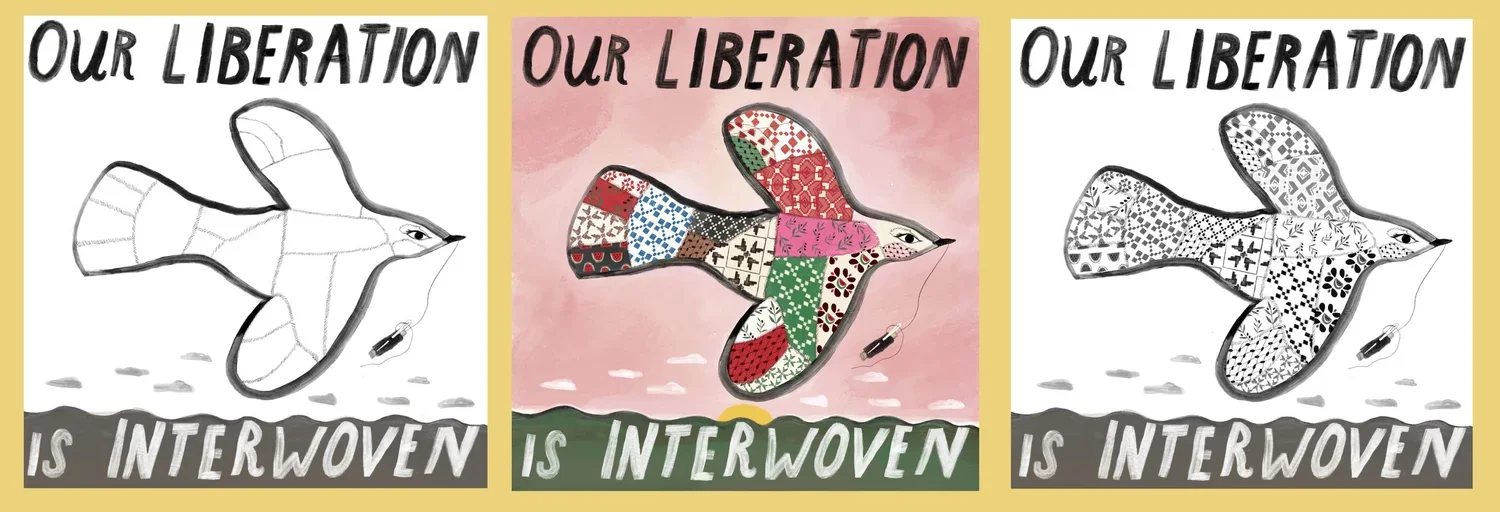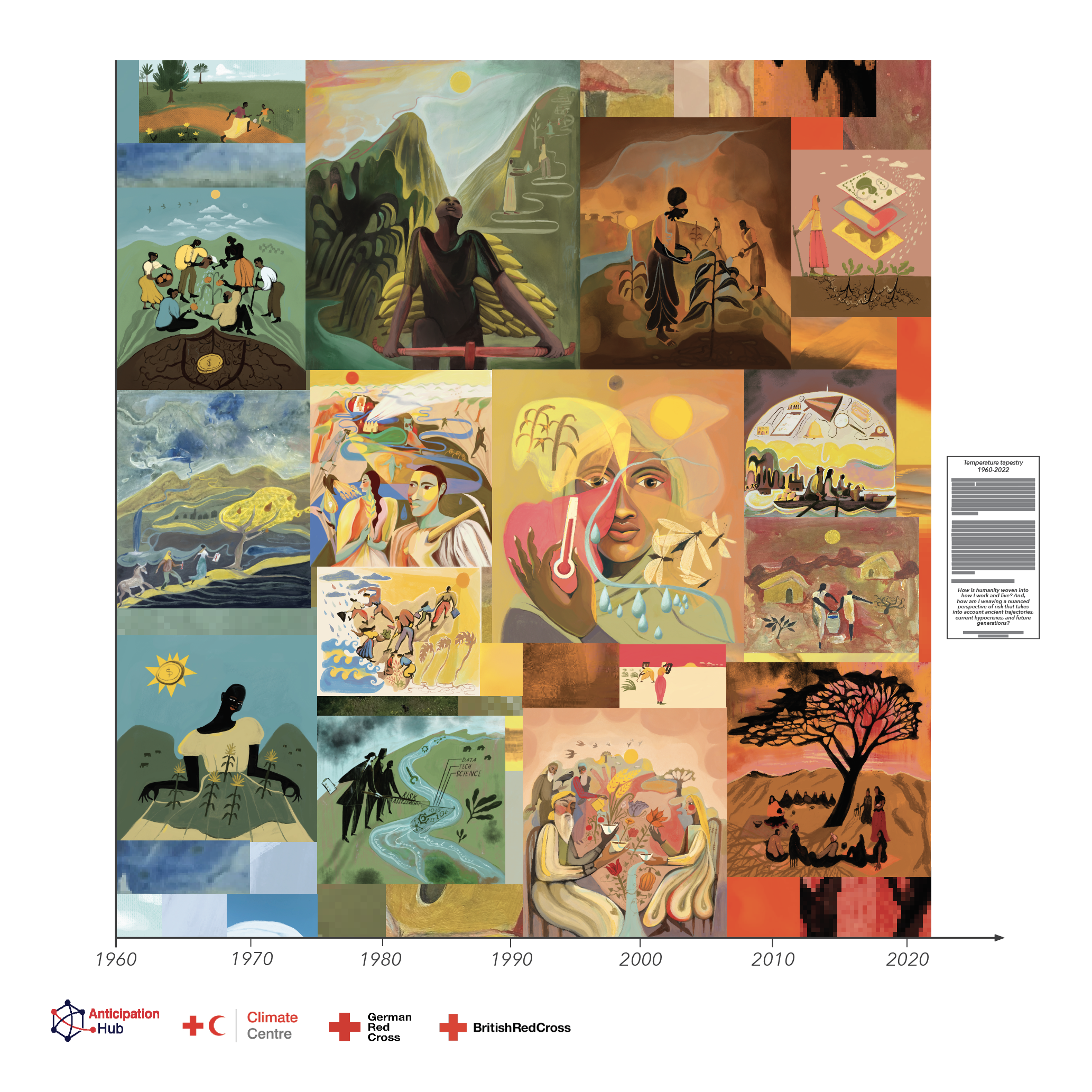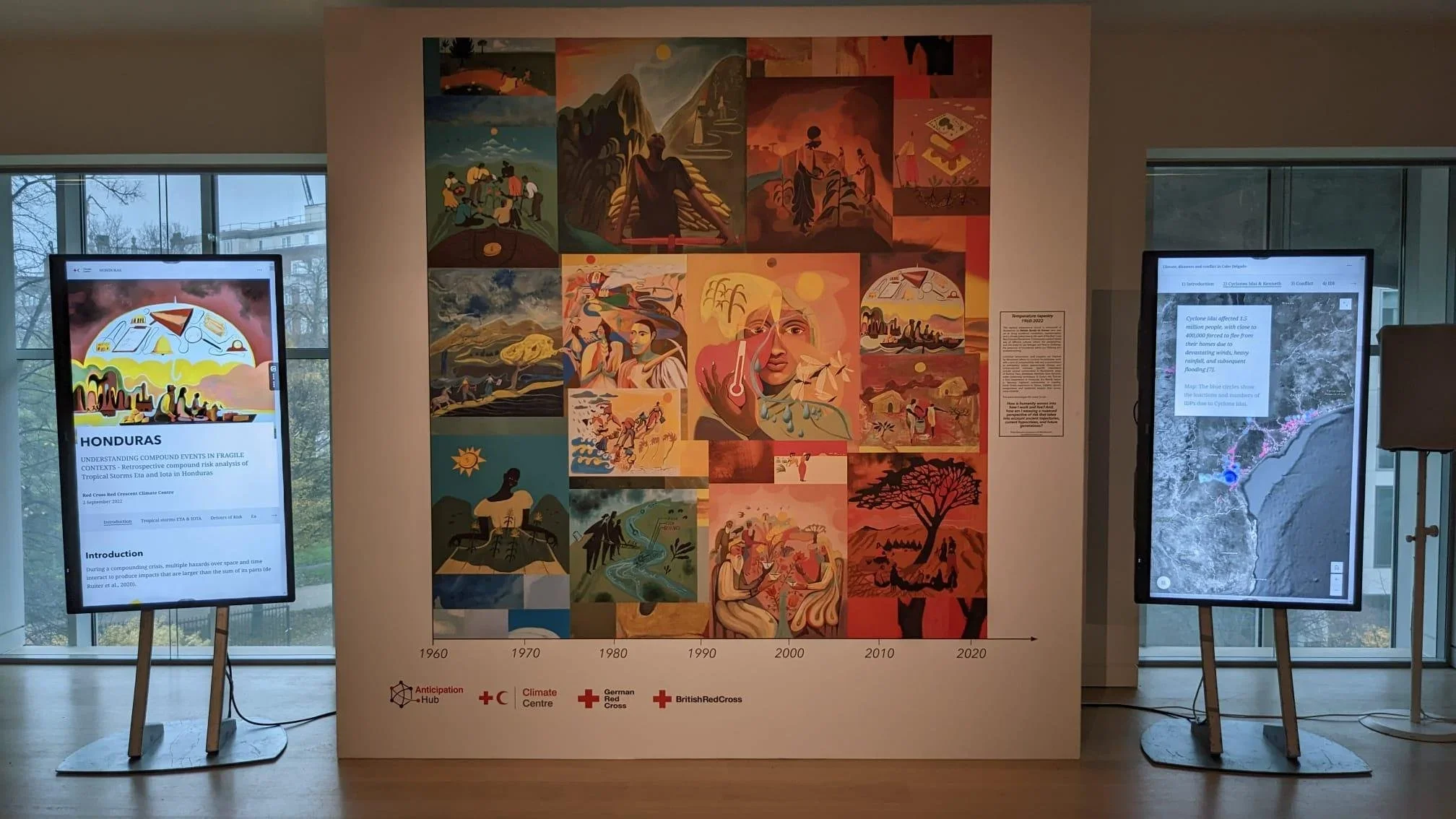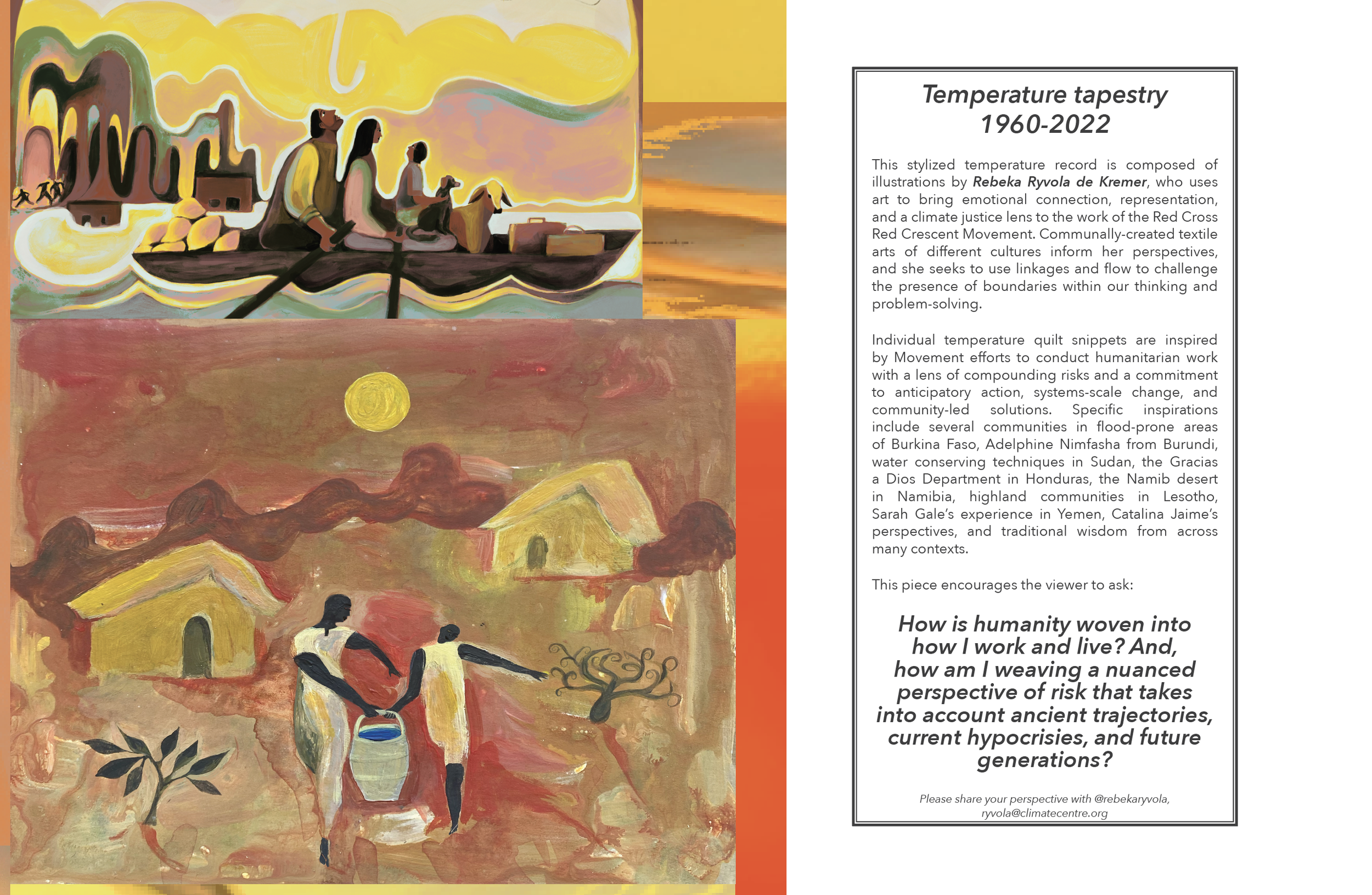Artworks for a range of publications, projects, programs, websites.
Illustrations for the Red Cross Red Crescent Climate Centre, 2025
Artworks for a range of publications, projects, programs, websites.
Artworks for a range of publications, projects, programs, websites.
An ongoing meditation on places, memories, stories, and feelings. I most highly recommend, can be digital or printed collage or paint, or other materials. These photos are mix of my own and ones sourced from friends, colleagues, and Google maps. They are created for client commissions, Red Cross Red Crescent Movement collaborations, and personal projects.
When I started The Heart Gallery podcast, it was to fulfill a years-long (life-long?!) desire to ask wise and wonderful people endless questions about issues that matter to me.Over two seasons, a few themes began to rise up: how art can help shift values both individually and collectively and how imagination can be a real tool for creating systems based in justice and care. That's where Imagination State came from. The first season had 7 episodes, and the podcast will be back in 2026.
The Imagination Threshold series was a short collaborative experiment I ran on Instagram before deciding not to be on Instagram anymore. It came from themes I explored during a residency at Philadelphia Art Museum, and also in different work projects that asked what it might mean to cultivate imagination more intentionally on both individual and collective levels.
I think of an Imagination Threshold as any kind of doorway that opens into deeper, clearer ways of engaging with the world and with each other. These invitations were a kind of three-way collaboration: between different experiences of the world that came from photos people shared with me; my responses to those experiences; plus the voice of someone from what I think of as the imagination frontlines: writers, artists, and others who are offering visions of more vibrant, inclusive futures that hold space for all of us.
Women Plus Water increases the visibility of women in water and engages people through the annual conversation series, expert list, and mentorship opportunities to learn about the gendered impacts of water research, management, and decision-making. Women Plus Water gives women, young professionals, and allies of all identities opportunities for professional development while empowering a global network of water experts committed to diversity, equity, inclusion, and justice in water. <— From the Women Plus Water event page.

The Art-Climate Nexus conversation featured:
Dani Lindamood
Program Director, Water Watchers
Co-Founder of Girls Gone Water Project
Dr. Andrew Denton
Faculty, School for the Arts
Director, School for the Arts
University of Saskatchewan
Rebeka Ryvola
Visual artist and creative communications advisor
Host of the Heart Gallery podcast
And was moderated by:
jake moore
Head of University Art Galleries and Art Collection
Faculty, School for the Arts
University of Saskatchewan
An ongoing portrait initiative that experiments with layered narratives - at personal, community, environment, and worldview levels - nested within each other.
Read MoreArtworks for publications, projects, programs, websites.
While panels with experts can be wonderful, it’s even more fantastic to have all of us in conversation together. I loved bringing a community conversation to my moderation of one of AGU 2024’s main plenary sessions. The session, 2024 Arts & Science Plenary - What's Next for Corals?, featured NOAA coral reef ecologist, Derek Manzello, and acclaimed artist and ocean advocate, Courtney Mattison. The presentations explored the future of corals amidst the pressing challenges of climate change, through lenses of coral reef monitoring and Courtney’s utterly breathtaking ceramic sculptures. Throughout the session, I was able to bring in the audience at various points, asking questions that built from a general temperature check to deeper explorations around hope, despair, imagining radically, and how we can grow our capacity to care — both for corals and for the broader earth systems and creatures within them. The capture of the 400-person community conversation was made possible by game developer Good Games.
Photos from Dwight Owens & Louise Arnal: Orchestrators Extraordinaires.
I started podcasting with The Heart Gallery: nineteen conversations with artists, writers, illustrators, and teachers who shared stories about applying arts, creativity, and care to global challenges. I was overjoyed to get to have each and every one of these conversations and I loved the frenetic challenge of painting the episode art in time for every episode. Two seasons, 2023 - 2024. Podcast website here.
For years, I used to travel with a camera. We just relocated to Buenos Aires from Philadelphia, USA, and the new energy and new eyes that come with a new setting reminded me of that photographer’s searching sensation, roaming around at some magic o’clock, looking for enchanted moments and scenes. Since I’m updating this website currently, here are some favorite photos and memories rescued from various archived Squarespace pages.
I recently had the good fortune of welcoming Washington, DC–based filmmaker and all-around creative extraordinaire Nick Brengle to my studio, where he filmed a profile for his series on DC artists. We spent hours talking about climate justice, books, music, podcasting, the visual storytelling of data and ideas, and why textile arts are a red thread through the work I do.
Reposted from the Red Cross Red Crescent Climate Centre:
The American Red Cross selected the Juneteenth holiday on 19th of the month that commemorates the end of slavery in the US to unveil a mural painted specially by the Climate Centre for global heat action day as an ode to environmental and climate justice.
The event (gallery here) organized by the National Capital and Greater Chesapeake Region of the American Red Cross coincided with the current expanding and dangerous heatwave in the US, and underscored the urgent need for preparedness and community resilience.
The mural features symbols of the reduction and prevention of heat stress, such as planting trees, creating green spaces, and spending time in the shade – crucial measures as rising temperatures and extreme weather affect the most vulnerable populations.
But “empowered and equipped” communities are essential for making such strategies effective, said Climate Centre resident artist Rebeka Ryvola de Kremer, who painted the mural.
“My inspiration came from environmental and climate justice efforts observed locally in Washington, DC and across the US. The strength of communities in addressing environmental harms and preparing for a changing climate is a central theme of the artwork.
“The piece showcases individuals who have significantly contributed to environmental and climate justice, highlighting the strides in, especially, vulnerable African-American communities.”
Among the African-American personalities depicted are Hazel Johnson and Robert Bullard, often referred to as the mother and father of environmental justice. The late Hazel Johnson was a pioneering figure who linked industrial pollutants in air, water and land to adverse health impacts in her Chicago community. Robert Bullard began collecting data on the health impacts of environmental conditions in the 1970s – a time when little investigation was being done in the low-income communities where pollution tends to be concentrated.
“The mural’s outdoor dinner scene symbolizes inclusivity and community,” Ryvola de Kremer added. “It underscores the idea that all community members deserve to experience well-being and belonging in the face of climate change. This message is reinforced by the diverse group of leaders and heroes depicted, showing that every individual can contribute to creating thriving communities.“
The 2024 Juneteenth day, which has been observed since 1866, saw participants at the unveiling of the mural help paint its final elements themselves.
This mural project was part of events for the 2025 June Heat Action Day in the US, marked globally every year since 2022; National Societies around the world observed it this year with a huge array of activities centred on urban art as a platform for raising awareness of the dangers of the extreme heat.
The first-ever global summit on extreme heat was hosted in March jointly by the United States Agency for International Development and the IFRC, gathering political and civil society leaders, and representatives of the private sector and the world’s most affected communities.
Photos below by Mariah Miranda.
I was elated to have these three pieces at the Human Impacts Institute’s Creative Climate Awards in New York, April 21-May 20. All three of these pieces center women from communities highly impacted by an increasingly volatile climate. In such places, it’s so often the case that women are leading the most exciting resilience-building and adaptation work. My goal with each of these pieces was to contribute to the unflattening of narratives about people in the frontlines of climate change, and spotlight people caring the most for the others, human and nonhuman, around them. Two of these pieces were in support of research from the Food and Agriculture Organization and the Red Cross Red Crescent Climate Centre on pollution, heat, and agriculture.
Artworks for a range of publications, projects, programs, websites.

This poster was created for Gaza (and Palestine more broadly) peace advocacy efforts led by Remember Who Made Them and the Anti-Sweatshop Activists Against Apartheid. The colored version is composed of textile patterns inspired by Palestinian Tatreez embroidery. The couple touches of color other than red, green, white, black to hint at the interweaving of liberation efforts and solidarity across all of humanity.
Two black and white versions are available for anyone wanting to create textile patterns of their own. My personal favorite textiles include the quilts from Gees Bend, Czech folkloric patterns that I grew up with, Rawandan block prints (especially a yellow version on a dress from my husband), mid-century weaving samples made by my great grandmother, and a very special quilt made by my best friends for my baby.
Download for peaceful protests, to put on telephone poles, bulletin boards, and walls, on front doors, etc, or for inspiration in your own projects. If you are drawn to create an actual textile version (freeform sewing, as a needlepoint backing, and simply pasting scraps of fabric could all work), I would be most inspired by you! This is a shout out to the young women I met in the street while putting up posters :-)
Download PDFs: Full Color | Tatreez Pattern | Blank pattern
Download PNGs: Full Color | Tatreez Pattern | Blank pattern
This piece is composed of many - most! - illustrations to date for various Red Cross and Red Crescent National Societies, the ICRC | International Committee of the Red Cross delegations and HQ, the Climate Centre, and the IFRC, arranged like a quilt from cooler to warmer. It was such a joy to see interconnections between the different stories and communities featured in these little shapes. The installation was created for the Design Museum London in conjunction with an anticipatory action convening and was made possible by my fabulous colleague Catalina Jaime Sanchez.



This guerrilla art gallery at the perimeter of the Russian Embassy in Washington DC was an attempt to bring outrage out of the screens and as close to the perpetrators as possible.
This effort was inspired by Yo-Yo Ma’s solitary performance in this same spot a few days earlier, and the art was inspired by Eastern European folkloric motifs and symbols, as well as Ukrainian children’s art being created in bomb shelters and basements.
The Virtual Water Gallery is a GWF-funded science and art pilot project that aims to provide a safe, inclusive and collaborative space for fully open discussions between scientists, artists, and the general public, to explore past, present and future water-related (scientific) challenges. As part of this pilot project, 11-13 Canada-based artists connected with teams of GWF scientists to co-explore specific water-related challenges. These collaborations led to the creation of art pieces by the artists (with a variety of art media) to be exhibited online through a Virtual Water Gallery in Spring 2021. Afterwards, the Virtual Water Gallery will be online for all to see and interact with, with the hope is that these art pieces open up discussions about pressing water related challenges to a wider audience via the gallery space.
I collaborated with Patrick Cheechoo, who is Moose River Cree from Constance Lake First Nation, on two art pieces dedicated to the principles of “braiding” together traditional Indigenous knowledge with western science.
Mentions:
The Virtual Water Gallery: Art as a catalyst for transforming knowledge and behaviour in water and climate Arnal L, Schuster-Wallace C (2025) The Virtual Water Gallery: Art as a catalyst for transforming knowledge and behaviour in water and climate. PLOS Climate 4(4): e0000398.
Laurier researchers combine science with art for Global Water Futures virtual gallery
I facilitated and visually captured three conversations centered on humanitarian and environmental challenges through the lens of philosopher Roman Krznaric’s longtermism. The conversations were with improvisational theater teacher and professor Barb Tint, meteorologist Eric Holthaus, public health expert Michael Adekunle Charles, youth leader Dainalyn Swaby, social-ecological systems scholar Rhoda Malgas, and Roman Krznaric himself. Held in the early months of the pandemic, these dialogues aimed to foster connection and collective imagination at a time of deep uncertainty by inviting participants to envision futures rooted in care, justice, and long-term thinking.